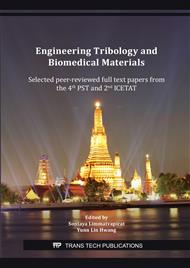p.67
p.73
p.79
p.86
p.92
p.98
p.104
p.111
p.117
Development of Triphala Extract-Loaded Mucoadhesive Films for Aphthous Ulcers
Abstract:
Triphala is a traditional Thai herbal formulation containing dried fruits of Phyllanthus emblica, Terminalia bellirica, and Terminalia chebula. It has wound healing, antioxidant and anti-inflammatory activities. The objective of this research was to formulate mucoadhesive films containing Triphala extract for aphthous ulcers treatment. The films were formulated using hydroxypropyl methylcellulose, HPMC, (5, 8, 10% w/w) as a film-forming polymer and glycerin (5% w/w) as a plasticizer. Triphala extract (2.5, 5, 10% w/w) was incorporated into the film during the film preparation. The films were then evaluated for the physical appearance, dissolution time, mechanical properties (strength and elasticity) and mucoadhesive capability to the porcine buccal mucosa. The antioxidant activity and anti-inflammatory activity of the films were also evaluated by DPPH assay and the proteins denaturation method, respectively. Physical properties revealed that Triphala-loaded HPMC films were transparent with brown color. All formulations showed 1-2 hr of dissolution times. Triphala films exhibited good mucoadhesive properties. Films prepared from the solution containing HPMC (10% w/w), glycerin (5% w/w), and Triphala extract (10% w/w) were the most appropriate formulation for further development due to suitable strength, elasticity, and mucoadhesive properties. Moreover, the films exhibited antioxidants and anti-inflammatory activity which may help relieve the symptom of aphthous ulcers.
Info:
Periodical:
Pages:
92-97
Citation:
Online since:
October 2021
Price:
Сopyright:
© 2021 Trans Tech Publications Ltd. All Rights Reserved
Share:
Citation:


